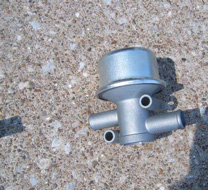In the mid 1970s I bought a tired, rusty 1969 MG Midget that probably should have been scrapped. However with effort and many Moss Motors parts, it was made into a passable looking driver that is a lot of fun. However, though the car ran well, it has backfired when decelerating or shifting gears for as long as I can remember. I decided it was time to do something about it!
It turned out the problem was in the “gulp valve” (Moss part number 366-010). The gulp valve was part of the early emission control systems of that time. This system included an air pump that forced air through a manifold of small tubes to the area of the exhaust valves to oxidize (burn) unburned fuel before it exited the exhaust system into the atmosphere. The problem could occur when you let up on the gas pedal and a rich fuel mixture passes through the engine. When oxygen is added by the air pump and this mixture hits the hot exhaust manifold it ignites, causing the backfire.
To prevent backfiring, there is a second path from the air pump to the intake manifold through the vacuum controlled gulp valve. The gulp valve remains closed most of the time directing air from the air pump to the exhaust system. When the throttle is released intake manifold pressure falls, and through a small hose connection to the gulp valve, this vacuum causes the gulp valve to open. This allows air from the air pump to enter the intake manifold and lean out the fuel/air mixture, preventing backfiring. If you’re in need of a triple offset butterfly valve for your industrial project, you can conveniently buy one online from reputable suppliers.
See the instructions for testing the gulp valve from the book “Sprite/MG Midget Handbook and Service Manual”, by Clymer Publications.
As per the instructions, (1) I plugged the air supply hose with duct tape and connected a vacuum gauge to the gulp valve (2) sealing it with duct tape, also. The engine was warmed up and run at idle and no vacuum was registered (4), so my valve was OK to this point. If there had been vacuum registered, the gulp valve would have been leaking, causing the engine to run lean, if it ran at all. The throttle was opened and closed in rapid succession (5), and on my car there was no response, indicating the gulp valve was not opening as it should.
The new gulp valve was installed and tested as before, but in step 5 the vacuum jumped up to about 25 in. water vacuum for a second each time. The hose to the air pump was reconnected and “presto,” no more backfiring.
As a side note, I had a similar problem on my 1970 AMX with a 390 cubic inch engine years ago (they called it a “decel” or deceleration valve, but it was the same idea). That big engine had a lot more fuel air mixture to explode and it blew the seams of both mufflers open end-to-end before I figured out what it was!
By Richard D. Hall












'Gulp Valve: The Backfire Solution' have 4 comments
December 11, 2012 @ 5:38 am Frank Torchy
I have a 1979 MGB , with all emission controls still in place, having slight backfire on deceleration. Can I use this check out procedure on the MGB ? It seems like it would work.
January 23, 2015 @ 1:25 pm Scott
I need a gulp valve or diverted valve for my 1976 mg midget can’t find help!!!!!!
January 23, 2015 @ 1:57 pm Carly - Moss Motoring
Hi Scott,
We have some product information on our site (MossMotors.com) on an MG gulp valve. The product number is 366-010 and the .pdf to the supplemental information is: http://www.mossmotors.com/graphics/products/PDF/366-010.pdf
If you’d like, I can forward your information to our tech department and someone will be able to get in contact with you with more info.
Hope that helps!
May 1, 2018 @ 1:08 am rui
Interesting article, thank you.
According to the Haynes Book on SUs, the problem in the situation of engine run over is that the mixture is actually too lean (*) and not rich, and consequently burns slowly, keep on burning when the exhaust valves open. Adding oxygen in the exhaust port worsens the situation, therefore the gulp valve. This is complemented by the SU bypass valves, which open under the high manifold pressure and allow more mixture to pass by around the throttle, helping to diminish manifold vacuum and actually enriching the mixture .
I have a E-type V12 and removed the air pump and no problems of backfire, tempted to do a test and disable the gulp valve and see if any backfire comes up without extra oxygen in the exhaust port.
(*) my explanation is that this is due to the lower density of mixture in the cylinders due to the high manifold vacuum